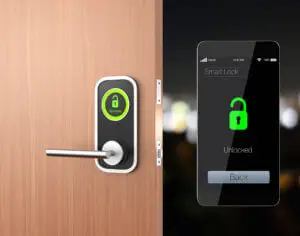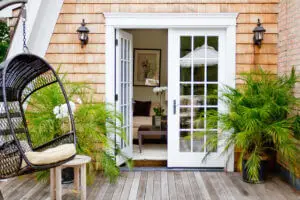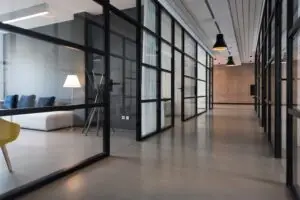Sliding doors are beautiful, space-saving, and let in tons of natural light. But here’s the problem: they’re often the weakest security point in your home. Standard sliding door locks are notoriously easy to bypass, and many homeowners don’t realize how vulnerable they are until it’s too late.
This guide breaks down everything you need to know about sliding door locks – from how they work to which ones actually keep intruders out. We’ll show you the best options on the market and help you choose the right lock for your specific needs. By the end, you’ll know exactly how to secure your sliding doors without sacrificing style or convenience.
The Evolution of Sliding Door Locks
From Traditional to Modern Mechanisms
Sliding door locks have come a long way from the basic latches of decades past. Early sliding doors relied on simple hook-and-eye mechanisms or basic turn locks that offered minimal security. These primitive systems were designed more for privacy than protection.
The 1980s brought the first major improvement with the introduction of keyed sliding door locks. These systems used traditional key cylinders mounted on the door frame, providing actual security rather than just keeping doors closed. However, early keyed systems had significant flaws – they were often poorly integrated with the door mechanism and could be easily defeated.
Modern sliding door locks incorporate multiple security layers. Today’s best systems combine keyed cylinders with anti-lift devices, reinforced strike plates, and even smart technology. The focus has shifted from simply locking the door to creating a comprehensive security system that addresses all common attack methods.
The biggest game-changer has been the recognition that sliding doors face unique security challenges. Unlike hinged doors, sliding doors can be lifted off their tracks, pushed out of their frames, or attacked at multiple points. Modern lock designs specifically address these vulnerabilities.
Key Developments in Locking Technology
Smart lock integration represents the newest frontier in sliding door security. These systems allow remote monitoring, temporary access codes, and integration with home security systems. While still emerging, smart sliding door locks are becoming more reliable and affordable.
Anti-lift technology has become standard in quality sliding door locks. These mechanisms prevent intruders from simply lifting the door out of its track – a common attack method that bypasses traditional locks entirely. The best systems use both top and bottom anti-lift devices.
Multi-point locking systems secure the door at several locations simultaneously. Instead of relying on a single lock point, these systems engage multiple bolts or hooks along the door’s length, distributing force and making forced entry much more difficult.
Reinforced materials and construction have dramatically improved lock durability. Modern sliding door locks use hardened steel components, corrosion-resistant finishes, and precision manufacturing that ensures smooth operation for years.
Sliding Glass Door Locks: A Deep Dive
Mechanisms and Materials
Understanding how sliding door locks work helps you choose the right system and use it properly. Most sliding door locks operate on one of three basic principles: cylinder locks, mortise locks, or surface-mounted systems.
Cylinder Locks are the most common type, using a traditional key-operated cylinder similar to those found on entry doors. The cylinder connects to a bolt mechanism that secures the door to the frame. Quality cylinder locks use hardened steel bolts and reinforced strike plates to resist forced entry.
Mortise Locks are built into the door itself, creating a more integrated and secure system. These locks typically offer superior strength because they’re supported by the door’s entire structure rather than just surface mounting hardware. However, they require professional installation and are more expensive.
Surface-Mounted Systems attach to the door’s surface and are easier to install. While generally less secure than mortise systems, high-quality surface mounts can provide excellent protection when properly installed with reinforced mounting hardware.
Material selection critically affects both security and longevity. Stainless steel components resist corrosion in humid environments, while hardened steel provides maximum strength. Avoid locks with significant aluminum or plastic components in security-critical areas.
Vulnerabilities and Solutions
Sliding doors face unique security challenges that traditional door locks don’t address. The most common vulnerabilities include track lifting, frame flexing, and glass breakage bypass.
Track Lifting occurs when intruders lift the entire door out of its bottom track. This completely bypasses the lock mechanism. Quality anti-lift devices prevent this by securing the door to the top track or using pins that engage when the door is closed.
Frame Flexing happens when force is applied to the door frame, creating enough space to slip the lock bolt. Reinforced strike plates and longer bolts help resist this attack. Some systems use multiple engagement points to distribute force across the entire frame.
Glass Breakage allows intruders to reach through broken glass and operate the lock from inside. Locks with keyed cylinders on both sides prevent this, though they require careful key management to avoid lockouts during emergencies.
Prying Attacks target the gap between the door and frame. Security bars, reinforced frames, and properly adjusted doors minimize these gaps. Some locks include built-in reinforcement plates that strengthen the door’s edge.
Choosing the Right Lock for Your Sliding Door
Keyed vs. Keyless Systems
The choice between keyed and keyless sliding door locks depends on your security needs, convenience preferences, and budget. Each system offers distinct advantages and drawbacks.
- Keyed Systems provides traditional security with physical keys. They’re generally more affordable, reliable, and familiar to most users. Keyed locks don’t require batteries or maintenance of electronic components. However, keys can be lost, copied, or forgotten, and there’s no remote access capability.
- Keyless Systems include combination locks, smart locks, and biometric systems. These eliminate key management issues and often provide additional features like access logging, temporary codes, and remote operation. The downside is higher cost, battery dependency, and potential electronic failures.
- Hybrid Systems combine keyed and keyless features, offering mechanical backup for electronic systems. These provide the best of both worlds, but at a higher cost and complexity.
For most homeowners, a quality keyed system provides the best balance of security, reliability, and cost. Consider keyless systems if you frequently need to provide access to others or want integration with smart home systems.
Material Considerations: Metal, Plastic, and More
Lock materials directly impact security, durability, and appearance. Understanding material properties helps you make informed decisions about long-term performance and security.
Stainless Steel offers the best combination of strength and corrosion resistance. It maintains its appearance in harsh weather and resists both cutting and drilling attacks. Premium stainless steel components justify higher costs through superior longevity.
Hardened Steel provides maximum security against cutting and drilling, but may rust without proper coating. Look for powder-coated or plated hardened steel components for the best protection.
Brass combines good security withan attractive appearance and natural corrosion resistance. It’s softer than steel but much stronger than aluminum or plastic. Brass components often indicate quality construction.
Aluminum is lightweight and corrosion-resistant but offers limited security. It’s acceptable for internal mechanisms but should be avoided for security-critical components like bolts and strike plates.
Plastic Components should be limited to non-security functions like covers or decorative elements. Avoid locks with plastic bolts, cylinders, or other critical components.
Safety Features to Consider
Modern sliding door locks incorporate safety features that protect both security and occupant safety. These features can be crucial in emergency situations or daily use.
Emergency Release Mechanisms allow the door to be opened from inside without keys, even when locked. This is essential for fire safety and prevents lockouts during emergencies. Look for systems that provide security while maintaining emergency egress.
Thumbturn Operation from the inside eliminates the need for keys during normal exit. This provides convenience while maintaining security when properly implemented with anti-reach-through features.
Visual Indicators show lock status at a glance. Whether mechanical or electronic, clear indicators help ensure the door is properly secured and prevent accidental lockouts.
Child Safety Features prevent young children from operating the lock while allowing adult access. These might include height-mounted controls, two-stage operation, or other design features.
Top Recommendations for Sliding Door Locks
Prime-Line Keyed Sliding Door Lock
This affordable option provides solid basic security for most sliding glass doors. The keyed cylinder operates a spring-loaded bolt that secures the door to the frame, while the included anti-lift device prevents track lifting attacks.
Key Features: Keyed cylinder, anti-lift device, adjustable bolt, weather-resistant finish
Best For: Budget-conscious homeowners wanting reliable basic security
Pros: Affordable, easy installation, proven reliability, weather-resistant
Cons: Basic security level, no advanced features, limited customization
Defender Security Sliding Door Lock
A step up in security, this system combines a keyed lock with a reinforced strike plate and anti-lift mechanism. The hardened steel components provide better resistance to attack than basic locks.
Key Features: Hardened steel bolt, reinforced strike plate, dual anti-lift system, keyed alike option
Best For: Homeowners wanting enhanced security without premium pricing
Pros: Strong materials, comprehensive security features, professional appearance
Cons: More complex installation, higher cost than basic models
SRN TECH Smart Sliding Door Lock
Our flagship smart lock brings advanced technology to sliding door security. Bluetooth connectivity enables smartphone control, while the mechanical backup ensures access during electronic failures.
Key Features: Bluetooth connectivity, mechanical backup, access logging, temporary codes, weather-sealed electronics
Best For: Tech-savvy homeowners wanting maximum convenience and security
Pros: Advanced features, remote monitoring, no keys to lose, integration capabilities
Cons: Higher cost, battery dependency, learning curve
Yale Keyed Sliding Door Lock
Yale’s premium sliding door lock offers commercial-grade security in a residential package. The mortise-style mechanism integrates with the door for superior strength and security.
Key Features: Mortise construction, hardened steel components, anti-drill protection, premium finish options
Best For: Homeowners prioritizing maximum security and build quality
Pros: Exceptional security, premium materials, professional installation available
Cons: High cost, complex installation, may require door modification
Sliding Door Security Bar
While not a traditional lock, security bars provide excellent supplemental protection. They prevent the door from being opened even if the lock is defeated, and they’re visible deterrents to potential intruders.
Key Features: Adjustable length, non-slip feet, quick removal, multiple mounting options
Best For: Renters or homeowners wanting additional security without permanent installation
Pros: Affordable, no installation required, visible deterrent, dual-purpose
Cons: Not a complete security solution, can be cumbersome, aesthetics may not suit all homes
Smart Home Integration Options
Modern sliding door locks increasingly integrate with smart home systems, providing enhanced security and convenience. These systems can trigger lights, cameras, or alarms when doors are opened.
Key Features: Hub connectivity, automation triggers, remote monitoring, integration with security systems
Best For: Homeowners with existing smart home infrastructure
Pros: Comprehensive automation, remote monitoring, and integration benefits
Cons: Complex setup, dependency on home network, higher costs
Maintenance and Upkeep for Sliding Door Locks
Regular Checkups and Repairs
Proper maintenance keeps sliding door locks operating smoothly and securely. Regular attention prevents minor issues from becoming major problems and extends lock life significantly.
Monthly Inspections should include checking lock operation, inspecting for wear or damage, and ensuring proper door alignment. Look for signs of rust, loose components, or difficulty in operation.
Lubrication keeps moving parts operating smoothly. Use graphite powder for lock cylinders and light machine oil for mechanical components. Avoid heavy greases that can attract dirt and debris.
Track Cleaning ensures smooth door operation and proper lock engagement. Remove debris from tracks and check that doors close completely and align properly with strike plates.
Weather Sealing protects lock components from moisture and temperature extremes. Check seals around electronic components and replace them when they show signs of wear.
DIY Fixes vs. Professional Solutions
Understanding when to handle repairs yourself versus calling professionals can save money and ensure proper security.
DIY Appropriate Tasks include basic cleaning, lubrication, minor adjustments, and simple part replacements. These tasks require basic tools and don’t affect the lock’s security integrity.
Professional Required Work includes lock installation, major repairs, door alignment issues, and any work involving structural modifications. Professional installation ensures proper security and may be required for warranty coverage.
Safety Considerations should guide your decision. If you’re unsure about any repair or if the lock provides primary security for your home, professional service ensures proper function and security.
Cost vs. Security must be balanced. While DIY repairs save money, improper work can compromise security. Consider the value of what you’re protecting versus the cost of professional service.
Installation Tips for Maximum Security
Proper Positioning and Alignment
Correct installation is crucial for both security and smooth operation. Poor installation can compromise even the best lock systems.
Door Alignment must be perfect for proper lock engagement. Doors that don’t close completely or align properly with strike plates create security vulnerabilities and operational problems.
Strike Plate Reinforcement distributes force across the door frame, preventing frame failure during attack attempts. Use long screws that penetrate into the wall studs for maximum strength.
Anti-Lift Device Placement should secure the door at multiple points. Top-mounted devices are most effective, but bottom-mounted devices provide additional security.
Clearance Verification ensures the lock doesn’t interfere with door operation or other hardware. Test full door travel and lock operation before final installation.
Common Installation Mistakes
Avoiding these common errors ensures proper security and operation:
- Inadequate Fastening: Using short screws or inadequate anchors compromises security
- Poor Alignment: Misaligned doors prevent proper lock engagement
- Insufficient Clearance: Locks that interfere with door operation won’t be used properly
- Skipped Steps: Following the manufacturer’s instructions completely is essential for security
- Wrong Tools: Using proper tools ensures a clean installation and prevents damage
Conclusion
Sliding door security doesn’t have to be complicated or expensive. The right lock system provides excellent protection while maintaining the convenience and beauty that make sliding doors popular.
Whether you choose a basic keyed lock for essential security or a smart system for maximum convenience, the key is selecting a lock that matches your specific needs and using it consistently. Remember that even the best lock won’t protect you if it’s not properly installed or regularly maintained.
Don’t wait until after a break-in to upgrade your sliding door security. The locks we’ve reviewed provide proven protection at various price points, and proper installation ensures they’ll serve you well for years to come.
Ready to secure your sliding doors? Browse our complete selection of sliding door locks at SRN TECH, where advanced security meets everyday convenience. Your family’s safety and your peace of mind are worth the investment.





